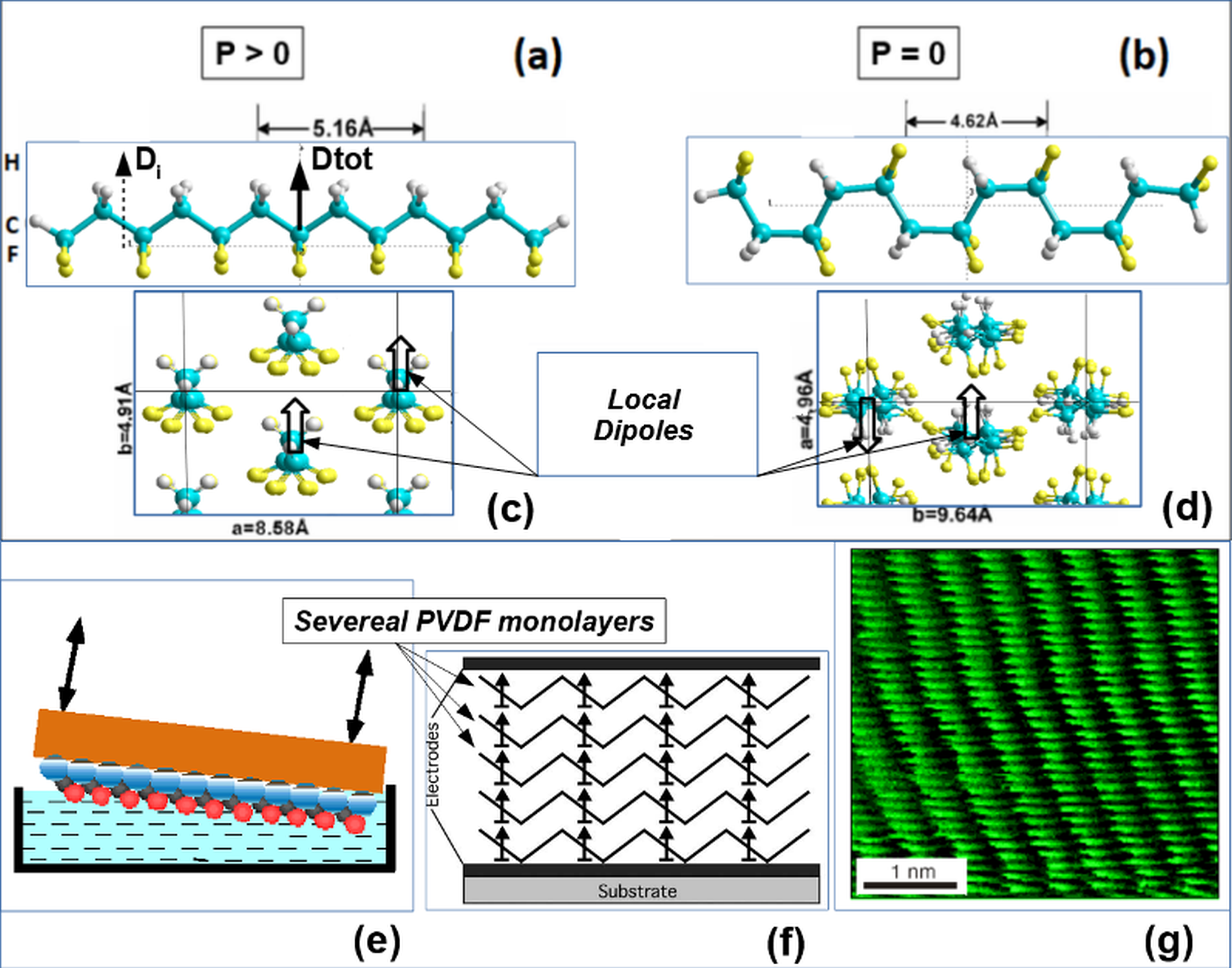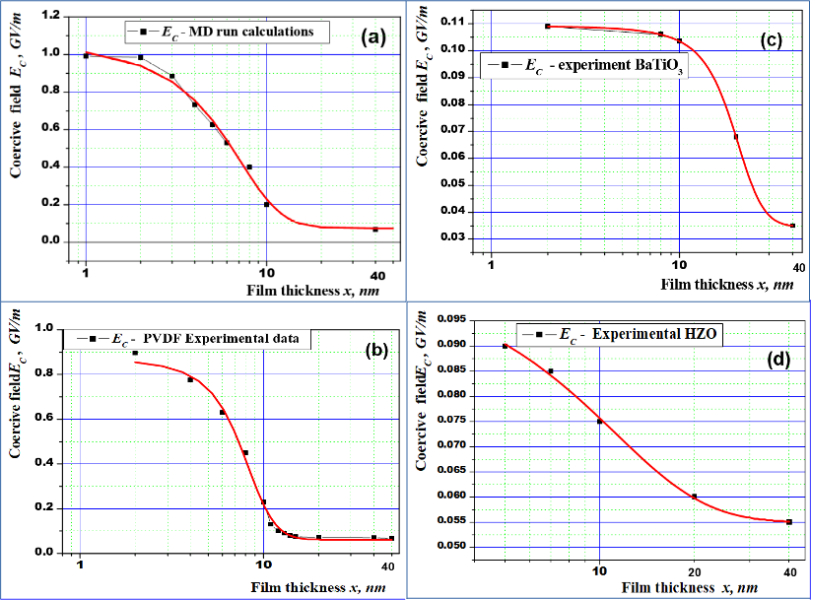This is a review of the Landau-Ginzburg-Devonshire (LGD) Theory applied for description of nanoscale ferroelectrirs. The polarization switching kinetics of nanosized ferroelectric crystals and the transition between homogeneous and domain switching in the nanoscale ferroelectric films are considered. Homogeneous switching according to the Ginzburg-Landau-Devonshire (LGD) theory is possible only in two-dimensional (2D) ferroelectrics. The main condition for the applicability of the LGD theory in such systems is its homogeneity along the polarization switching direction. A review is given of the experimental results for two-dimensional (2D) films of a ferroelectric polymer, nanosized barium titanate nanofilms, and hafnium oxide-based films. For ultrathin 2D ferroelectric polymer films, the results are confirmed by first-principle calculations. Fitting of the transition region from homogeneous to domain switching by sigmoidal Boltzmann functions was carried out. Boltzmann function fitting data enabled us to estimate correctly the region sizes of the homogeneous switching in which the LGD theory is valid. These sizes contain several lattice constants or monolayers of a nanosized ferroelectrics.
- LGD theory
- polarization
- nanoscale ferroelectrics
- kinetics
- homogeneous switching
- computer simulation
- fitting
1. Introduction
Studies of polarization switching in ultrathin (nanoscale) polymer ferroelectric films of polyvinylidene fluoride-trifluoroethylene (P(VDF-TrFE)), obtained experimentally by the Langmuir-Blodgett (LB) method [1,2,3,4,5,6,7], have shown that for nanosized (within the film thickness, when their sizes are less than or equal to the critical sizes required for the formation of a domain core), homogeneous non-domain switching of polarization is observed [1,6]. This occurs in accordance with the Landau theory of phase transitions [8], developed for ferroelectrics by Ginzburg and Devonshire (Ginzburg-Landau-Devonshire (LGD) theory) [8,9,10]. In such homogeneous media, the kinetics of the process and the time of polarization switching are well described by the Landau-Khalatnikov equation [11,12,13], in the approximation of continuous homogeneous media.
This was shown experimentally [13,14,15,16] and theoretically (in first-principle calculations [17], including with molecular dynamics (MD) approaches [18] and using quantum–mechanical semi-empirical methods [17,18,19,20]). The main condition for the applicability of the LGD theory in such systems is its homogeneity along the polarization switching direction.
It is clear that it is necessary to apply the numerical estimates obtained by the LGD theory with respect to specific and real ferroelectric samples (of any composition and geometry) with extreme caution, and it is necessary to take into account possible limitations and the approximate nature of the results obtained. Nevertheless, under certain conditions and for some structures, the estimates give quite reasonable values consistent with the experimental values, as we will see from the analysis of the results obtained for a number of different systems carried out in this article.
In this paper we do not deal with domain switching and consider only homogeneous switching and its transition to the domain one. But domain switching works well for the sizes when domain nuclei can already form—all these domain switching processes are remarkably described in the Tagantsev et al. monograph [21].
Naturally, many issues of domain formation and switching in various real systems remain quite complex and require careful analysis in each specific case. Note, in this case, that the phenomenological LGD theory itself does not answer all the questions and does not consider the mechanisms of polarization switching themselves (especially at the microscopic level). This is a continual theory and it describes the thermodynamics of changes in polarization during a phase transition, which is determined by the potential barrier between the polar and nonpolar phases in the LGD theory. This theory also considers the kinetics of changes in polarization in a homogeneous continuous medium according to the nonlinear Ladnau-Khalatnikov equations—again in the approximation of a homogeneous infinite medium. All this must be taken into account in applications to various real structures.
It is known that the LGD theory does not describe the switching of conventional bulk ferroelectrics, since it predicts the magnitude of the coercive field, which is 2 to 3 times higher than the experimental one. The large coercive fields predicted by the LGD theory came to be called intrinsic (or proper), and their experimental values are extrinsic (or improper).
Domain discovery helped resolve this inconsistency. As it turned out, such bulk ferroelectrics inevitably split into domains [21]. This division of the polar crystal into domains reduces the free energy of the crystal. In this case, the minimum of the free energy or thermodynamic potential of the crystal below the Curie point in the polar ferroelectric phase is achieved if the crystal is divided into domains.
The appearance of nanoscale ferroelectrics, namely, polymer ferroelectric films, the thickness of which reached the minimum possible values of one mono-molecular layer (~0.5 nm) [1,2,3,4,5,6,7], created a completely new and different situation.
The question of domain formation does not arise, since such layers are much smaller than the size of a possible domain (~10 nm [21]), but at the same time all these layers (as one layer and also all layers as a whole, if their formation is created from several layers) created significant spontaneous polarization in their polar phase. In this case, even the values of the coercive fields turned out to be much larger than those in bulk ferroelectrics and they were close to the values of the LGD theory. It became possible to talk about the applicability of the LGD theory here.
Thus, here and further in this article, we will not talk about the formation of domain nuclei and the growth of domains (and their role in polarization switching), but we are only talking about non-domain homogeneous polarization switching, under the conditions of a continuous homogeneous medium, when its size (thickness) does not exceed the dimensions of the formation of domains and one can speak of one continuous medium in the direction of polarization.
2. Main theoretical approach
2.1. Main relations
Let's take a quick introduction to LGD theory.
As it was written above, the values of the intrinsic coercive field EC are determined by the potential barrier between the polar and nonpolar phases as described by the polarization expansion coefficients of thermodynamic potential (or free energy) known from the LGD theory [4,5]:
|
|
(1) |
|
|
(2) |
where P0 = P(T = T0) = √(-β/γ), χ0 = χ(T = T0) = γ/2β2, f(t) is the function:
|
|
(3) |
and the reduced temperature is:
|
|
(4) |
Here, χ0 is the ferroelectric contribution to the dielectric susceptibility, and α, β, γ are coefficients of the expansion of free energy in even degrees of polarization, known from the LGD theory. For estimates, it can be assumed that approximately EC ~ P/χ0 ~ P/εε0, where ε is the relative permittivity and ε0 is the dielectric constant of the vacuum.
2.2. Kinetics of polarization switching
The polarization switching kinetics of two-dimensional polymer ferroelectrics was described by Landau – Khalatnikov equation [11] and its solution for first-order phase transitions in two-dimenstional ferroelectrics was considered in [12, 13]:

where is the damping coefficient. In the general case, the gradient term can be taken into account. An investigation of the solution of this equation showed that in the vicinity of the coercive field EC, the switching time sharply increases and its reciprocal can be expressed as [12]:

where 0
Otherwise

In this case, EC is the proper (or intrinsic) coercive field of the ferroelectrics. This relation (7) shows linear behaviour of-2 along E in the vicinity of EC (for E > EC).
This relation is more suitable for comparison with experimentally measured data and used in [14, 15, 18]. This relationship turned out to be convenient for analyzing the results of theoretical calculations when modeling the polarization switching processes in polymer ferroelectrics by molecular dynamics (MD) methods [18, 19].
2.3. Two-dimensional ferroelectrics
The discovery of two-dimensional ferroelectrics [1,2] led to a new stage of the polarization switching development using the study of switching of these ultrathin single-crystal films. A start was maid by the development of a new method for growing single-crystal ferroelectric polymer films of polyvinylidene fluoride-trifluoroethylene (P(VDF-TrFE)) [1-7].
Figure 1. Ferroelectric polymer polyvinylidene fluoride (PVDF): (a) and (c) PVDF in polar Trans conformation and total polarization P > 0; (b) and (d) PVDF in a nonpolar Gauche conformation with total polarization P = 0. Adapted with permission from ref. [23], with permission from AIP Publishing, 2012. (e) The formation of the PVDF Langmuir-Blodgett (LB) film on the surface of the water. Adapted with permission from ref. [4], with permission from Physics-Uspekhi copyright holder - Uspekhi Fizicheskikh Nauk , 2000. (d) Transferring several mono-layers (ML) of LB PVDF film onto a substrate with an electrode. Adapted with permission from ref. [24], with permission from IEEE, 2005. (e) Image of the 1 M LB film of polyvinylidene fluoride-trifluoroethylene P(VDF-TrFE) by scanning tunneling microscopy [1, 2]. Adapted with permission from ref. [2], with permission from Springer Nature, 1998.
To grow the ferroelectric films of this polymer, the Langmuir – Blodgett (LB) method [1-7, 14-16, 24] was used, based on the transfer of polymer chains (or mono-layers - ML) from the surface of the water to a substrate that carries an electrode. Fig. 1 (a) - (d) show polymer chains and cells in the polar (ferroelectric) and nonpolar (paraelectric) phases (these images were built using HyperChem tool [20]); Fig. 1 (e) - (g) show a transport scheme of LB layers and 1 ML observed in a scanning tunneling microscope. The Langmuir ferroelectric films obtained by this method in 1998 were thinner than any films obtained before. The thickness of one monolayer (1 ML) was 0.5 nm, that is, significantly less than the size of the critical domain nucleus known from the literature [21]. The thickness of Langmuir polymer films (two-dimensional ferroelectrics) was controlled by ellipsometry and atomic force spectroscopy, and two-dimensional ferroelectrics 0.5-1.0 nm thick were first obtained.
Experimental study [14, 15] and computational simulation [17-19] of the polarization switching, carried out on this ultra-thin polymer ferroelectrics have confirmed relationships (6), (7). The MD approach calculations [18, 19] were carried out using HyperChem software [20], using various modes and semi-empirical methods (PM3, etc.) for correct quantum-chemical calculations at each step of the MD simulation run process. As an example of the MD run calculations, simple 2 PVDF chains affected by an external electric filed E are presented (Fig. 2).
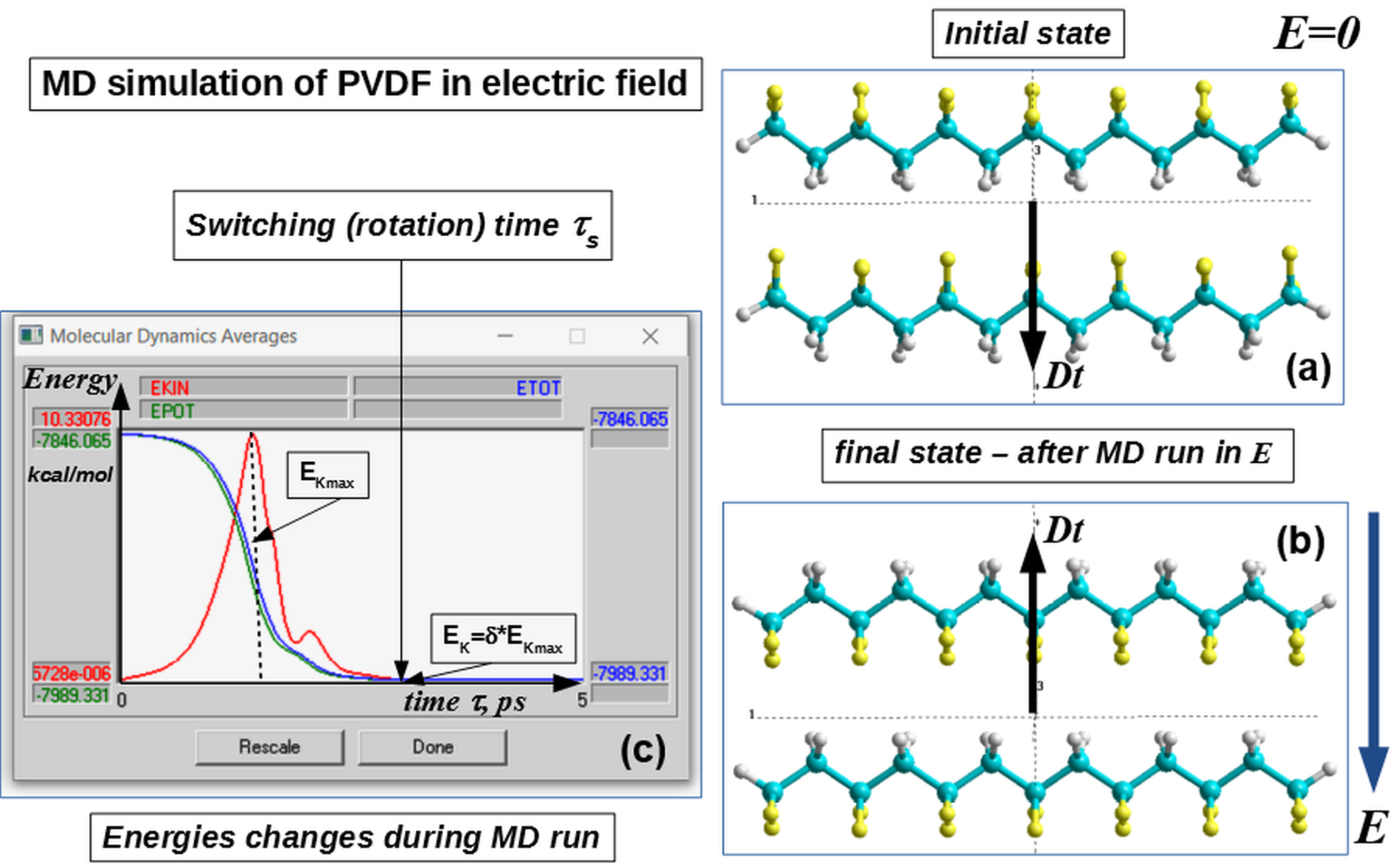
Figure 2. Scheme of the MD run process for 2 PVDF-6 chains model with PM3 (in restricted Hartree-Fock approximation - RHF) calculations at each MD run step: (a) initial state; (b) final state after MD run with dipole moment D orientation turned (switched) in the opposite direction in electric field E; (c) changes of MD averages energies trajectory over time during MD run (in ps) and time of the switching s for this PVDF system (red – kinetic energy, blue – total energy, green – potential energy). Adapted with permission from ref. [18], with permission from Elsevier, 2014.
The final time, for example, for the case of two-chain model rotation (switching time τS) was estimated from these MD energy trajectories (see Fig. 2 c) using criteria [18]: δ = EK/EKmax <10–3, where EK is the kinetic energy at the final point and EKmax is the kinetic energy at the maximum EKIN point of the chain rotation (as shown on Fig. 2 c). As result, this corresponds to reaching the rest point of the rotating chain and its new position from another opposite orientation of the total dipole Dt vector and polarization vector. With a similar precise we were calculated the values of the coercive field, obtained from a hysteresis loop, corresponding the switching of PVDF chain polarization into the opposite direction (or the same rotation of the PVDF chain). These data were used further in calculations of the thickness dependence of the coercive field (see below on Fig. 5).
3. Main results and discussion
3.1. Polymer Ferroelectrics
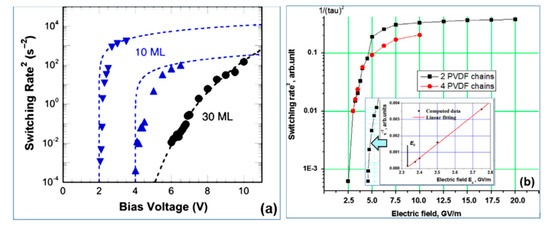
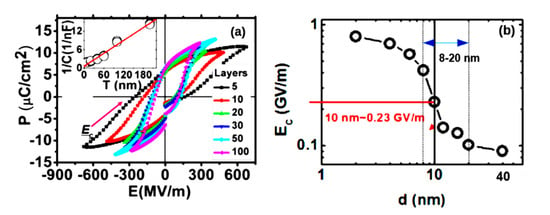
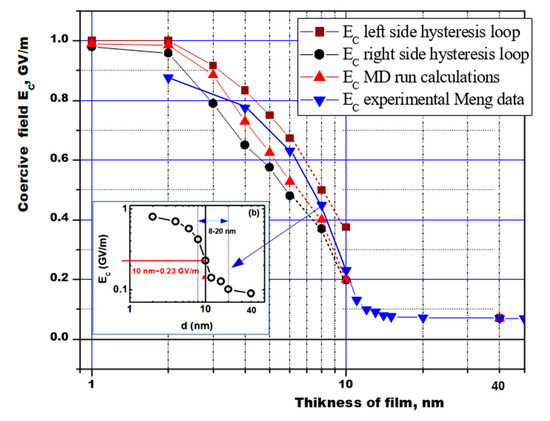
3.2. Barium titanate
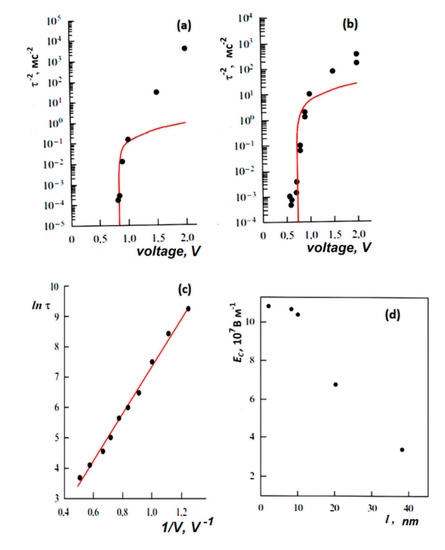
3.3. Nanosized materials based on the Hafnium Oxide
In the past few years, interest has also been wetnessed in nanoscale films based on hafnium oxide [33-36], including those doped with silicon and several types of their solid solutions, such as for example, Hf0.5Zr0.5O2 (HZO) [34, 35]. Ferroelectricity was found in them and the corresponding hysteresis loops (Fig. 7) suggest the proper intrinsic nature of the coercive field (~ 0.1 - 0.2 GV/m) here and, apparently, the homogeneous nature of the polarization switching. Though these samples are fully blended HZO solid solutions [36], there are some doubts as to whether they are fully homogenous, fully monocrystallic since they can consist of several phases. Therefore, it is too early to draw conclusions about homogeneous switching and its kinetics. But these studies are ongoing.
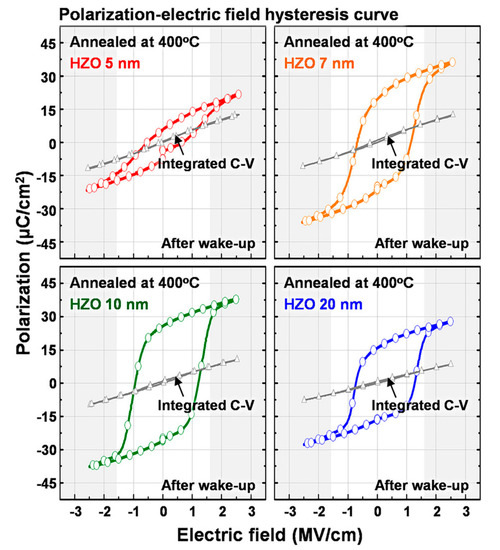
The dependence of the coercive field on the thickness of the ultrathin HZO films (4–20 nm) is also observed (some data are given in review [36]). However, there are no reliable and detailed measurements yet. Nevertheless, the study of these nanoscale films is of great interest and here we also tried to estimate whether their possible parameters match with homogeneous polarization switching. For example, one can estimate the data of [35] (Figure 7); at least approximately, they correspond to the dependence of the coercive field EC on the films’ thickness x in such HZO-based films.
3.4. Boltzmann function fitting data
Relying on the fact that the character of the transition region has a pronounced sigmoidal type for all the above-considered samples, we carried out fitting of various available experimental data in accordance with the formula of the sigmoidal Boltzmann function (in the form used by the OriginLab software) [37]:

where A1 and A2 are parameters of the maximum and minimum function values (corresponding to the values of the coercive field EC - a proper (intrinsic) and improper (extrinsic), x0 - is the average thickness of the films or samples corresponding to the middle of the transition region, and dx - is the effective half-width of the transition region.
The results obtained generally show that formula (8) describes rather well how a coercive field changes as the thickness of all the samples varies. See fitted data in Table 1.
Moreover, for PVDF, the values obtained from the experiment and those obtained by MD modeling and hysteresis loops (especially the left side) calculations are close (see in above Fig. 4, Fig. 5 and in Fig. 8 below).
Figure 8. Fitting of the thickness dependence of EC (x) for different nanoscale ferroelectrics and modeling with MD run calculations: a) PVDF thin film data using molecular chains modeling and MD run calculations [18]; b) LB PVDF thin films experimental data from [16]; c) thin single-crystal BaTiO3 epitaxial laser films [3, 22]; d) thin Hf0.5Zr0.5O2 (HZO) films based in the metal-insulator-metal (MIM) capacitor [30].
These values of the coercive field turn out to be the highest of all the experimental samples and indicate the existence of an intrinsic coercive field Ec up to sizes of at least 5-8 nm (which corresponds to 10 -16 ML; 1 ML = 0.5 nm [1-7]). That is, in this case, the existence of two-dimensional ferroelectrics is obvious up to ~10-16 PVDF ML (or up to ~ 8 nm).
At the same time, it turns out to be rather unexpected that for BaTiO3 the inflection point of sigmoid (8) here occurs at x0 ~ 19-20 nm, that is, here the region of existence of a homogeneous ferroelectric in this perovskite crystal structure is almost 3 times greater than that of a polymer PVDF film. For HZO, the order of the width of the region is ~ 5 nm, which is rather close to PVDF, but with a significantly larger half-width dx ~ 6 nm, meaning "smearing" of the transition region in a twice wider range. This, of course, is due to the insufficient number of accurate experimental data. It should be noted that the maximum value of Ec for barium titanate and HZO-based films turns out to be significantly lower than PVDF (almost by an order of magnitude). This, in principle, is not surprising and would be expected.
Thus, the proposed approach shows satisfactory fitting data and can be extended to the analysis of other similar data. Besides, it can be used to obtain significant parameters of two-dimensional ferroelectrics and homogeneous polarization switching in them.
5. Conclusions
The study of nanoscale ferroelectrics became possible for the first time when polymer ferroelectric films were synthesized by the Langmuir-Blodgett method [1-7]. This led to the discovery of two-dimensional ferroelectrics [2]. Soon, for classical perovskite ferroelectrics such as barium titanate, it became possible to create, by laser epitaxy, films several tens of nm thick [22]. The study of nanoscale perovskite films of barium titanate showed that they can also be two-dimensional ferroelectrics [1-4]. It can be assumed that other nanoscale single crystals can be two-dimensional and homogeneous. Recently, such nanoscale films have been obtained on the basis of hafnium oxide [33-36].
In this case, the phenomenological LGD theory describes well the switching kinetics, if only the medium is homogeneous and the size is slightly less or of the order of the critical size of the domain nucleus formation. It is the case of two-dimensional ferroelectrics. Thus, by two-dimensional ferroelectric we mean a nanoscale crystal, which in the direction of its switching can be considered to be homogeneous. It can consist, in principle, of several unit cells (or monolayers). Molecular modeling and quantum-mechanical calculations of polymer ferroelectrics using hysteresis loops and molecular dynamics methods showed their good agreement and the presence of a transition region from a homogeneous switching to a domain switching of several nm (6-20 nm) length, thereby convincingly confirming that two-dimensional ferroelectrics can have several monolayers and cells. Similar results were obtained for nanoscale barium titanate and hafnium oxide.
The sigmoidal nature (described by Boltzmann function (8)) of the transition region turned out to be common here. For various nanoscale ferroelectrics, it is possible to approximate quite effectively and thereby determine the important parameters of the transition region from maximal value A1 (corresponding to proper intrinsic coercive field Ес for nanoscale films) to minimal A2 value (corresponding to known improper coercive field in thick films and bulk crystals) with half-width dx and middle point x0. These parameters, in general, determine the region of homogeneous switching in such nanosized ferroelectrics.
Therefore, one should distinguish between the intrinsic coercive field EC for nanoscale homogeneous ferroelectric films and the previously known improper coercive field EC in thick films and crystals, associated with the domain mechanism. The intrinsic field is several orders of magnitude greater than the experimental (improper) one.
In fact, in nanoscale ferroelectric films there is a competition between these two ^switching mechanisms: homogeneous and domain. As a result, when the film thickness increases, the domain mechanism should prevail. Thus, this parameter x0 actually shows and estimates the size of the possible region of validity of the existence and applicability of the LGD theory for homogeneous polarization switching in the nanoscale ferroelectrics.
Aknowledgments: Author is very thankful to Fridkin V. M. for the fruitful collaboration and to the Russian Foundation for Basic Researches for grants # 19-01-00519_a and # 20-51-53014_a.
References
- Fridkin, V.M.; Ducharme, S. Ferroelectricity at the Nanoscale. Basic and Applications, 1st ed.; Springer: New York, NY, USA, 2014. [Google Scholar]
- Bune, A.V.; Fridkin, V.M.; Ducharme, S.; Blinov, L.M.; Palto, S.P.; Sorokin, A.V.; Yudin, S.G.; Zlatkin, A. Two-dimensional ferroelectric films. Nature 1998, 391, 874–877. [Google Scholar] [CrossRef]
- Fridkin, V.M.; Ducharme, S. Ferroelectricity at the nanoscale. Phys. Usp. 2014, 57, 597–603. [Google Scholar] [CrossRef]
- Blinov, L.M.; Fridkin, V.M.; Palto, S.P.; Bune, A.V.; Dowben, P.A.; Ducharme, S. Two-dimensional ferroelectrics. Phys. Usp. 2000, 43, 243–257. [Google Scholar] [CrossRef]
- Palto, S.; Blinov, L.; Bune, A.; Dubovik, E.; Fridkin, V.; Petukhova, N.; Verkhovskaya, K.; Yudin, S. Ferroelectric Langmuir-Blodgett films. Ferroelectr. Lett. 1995, 19, 65–68. [Google Scholar] [CrossRef]
- Bune, A.; Ducharme, S.; Fridkin, V.; Blinov, L.; Palto, S.; Petukhova, N.; Yudin, S. Novel switching phenomena in ferroelectric Langmuir–Blodgett films. Appl. Phys. Lett. 1995, 67, 3975. [Google Scholar] [CrossRef]
- Palto, S.; Blinov, L.; Bune, A.; Dubovik, E.; Fridkin, V.; Petukhova, N.; Verkhovskaya, K.; Yudin, S. Ferroelectric Langmuir-Blodgett films. Ferroelectrics 1996, 184, 127–129. [Google Scholar] [CrossRef]
- Landau, L.D. On the theory of phase transitions. Phys. Z. Sowjet. 1937, 11, 545. [Google Scholar] [CrossRef]
- Ginzburg, V.L. On the dielectric properties of ferroelectric (seignetteelectric) crystals and barium titanate. Zh. Eksp. Teor. Fiz. 1945, 15, 739–750. [Google Scholar]
- Ginzburg, V.L. On polarization and piezoelectric effect of barium titanate near the point of ferroelectric transition. Zh. Eksp. Teor. Fiz. 1949, 19, 36–41. [Google Scholar]
- Landau, L.D.; Khalatnikov, I.M. On the anomalous absorption of sound near a second-order phase transition point. Dokl. Akad. Nauk SSSR 1954, 96, 469. [Google Scholar]
- Vizdrik, G.; Ducharme, S.; Fridkin, V.M.; Yudin, S.G. Kinetic of ferroelectric switching in ultrathin films. Phys. Rev. B 2003, 68, 094113. [Google Scholar] [CrossRef]
- Ievlev, A.; Verkhovskaya, K.; Fridkin, V. Landau-Khalatnikov switching kinetics in the ferroelectric copolymers nanostructures. Ferroelectr. Lett. 2006, 33, 147–152. [Google Scholar] [CrossRef]
- Gaynutdinov, R.V.; Mitko, S.; Yudin, S.G.; Fridkin, V.M.; Ducharme, S. Polarization switching at the nanoscale in ferroelectric copolymer thin films. Appl. Phys. Lett. 2011, 99, 142904. [Google Scholar] [CrossRef]
- Gaynutdinov, R.; Yudin, S.; Ducharme, S.; Fridkin, V. Homogeneous switching in ultrathin ferroelectric films. J. Phys. Condens. Matter 2012, 24, 015902. [Google Scholar] [CrossRef] [PubMed]
- Wang, J.L.; Liu, B.L.; Zhao, X.L.; Tian, B.B.; Zou, Y.H.; Sun, S.; Shen, H.; Sun, J.L.; Meng, X.J.; Chu, J.H. Transition of the polarization switching from extrinsic to intrinsic in the ultrathin polyvinylidene fluoride homopolymer films. Appl. Phys. Lett. 2014, 104, 182907. [Google Scholar] [CrossRef]
- Bystrov, V.S.; Bystrova, N.K.; Paramonova, E.V.; Vizdrik, G.; Sapronova, A.V.; Kuehn, M.; Kliem, H.; Kholkin, A.L. First principle calculations of molecular polarization switching in P(VDF–TrFE) ferroelectric thin Langmuir–Blodgett films. J. Phys. Condens. Matter 2007, 19, 456210. [Google Scholar] [CrossRef]
- Bystrov, V.S. Molecular modeling and molecular dynamic simulation of the polarization switching phenomena in the ferroelectric polymers PVDF at the nanoscale. Phys. B Condens. Matter 2014, 432, 21–25. [Google Scholar] [CrossRef]
- Paramonova, E.V.; Filippov, S.V.; Gevorkyan, V.E.; Avakyan, L.A.; Meng, X.J.; Tian, B.B.; Wang, J.L.; Bystrov, V.S. Polarization switching in ultrathin polyvinylidene fluoride homopolymer ferroelectric films. Ferroelectrics 2017, 509, 143–157. [Google Scholar] [CrossRef]
- HyperChem (TM), Tools for Molecular Modeling; HyperChem 8.0, Professional Edition. Available online: http://www.hyper.com/?tabidD360 (accessed on 27 July 2020).
- Tagantsev, A.K.; Cross, L.E.; Fousek, J. Domains in Ferroelectric Crystals and Thin Films; Springer: New York, NY, USA, 2010. [Google Scholar]
- Gaynutdinov, R.; Minnekaev, M.; Mitko, S.; Tolstikhina, A.; Zenkevich, A.; Ducharme, S.; Fridkin, V. Polarization switching kinetics in ultrathin ferroelectric barium titanate film. Phys. B Condens. Matter 2013, 424, 8–12. [Google Scholar] [CrossRef]
- Bystrov, V.S.; Paramonova, E.V.; Dekhtyar, Y.; Pullar, R.C.; Katashev, A.; Polyaka, N.; Bystrova, A.V.; Sapronova, A.V.; Fridlin, V.M.; Kliem, H.; et al. Polarization of poly(vinylidene fluoride) and poly(vinylidene fluoride-trifluoroethylene) thin films revealed by emission spectroscopy with computational simulation during phase transition. J. Appl. Phys. 2012, 111, 104113. [Google Scholar] [CrossRef]
- Ducharme, S.; Reece, T.J.; Othon, C.M.; Rannow, R.K. Ferroelectric polymer Langmuir-Blodgett films for nonvolatile memory applications. IEEE Trans. Device Mater. Reliab. 2005, 5, 720–735. [Google Scholar] [CrossRef]
- Bystrov, V.S.; Paramonova, E.V.; Bdikin, I.K.; Bystrova, A.V.; Pullar, R.C.; Kholkin, A.L. Molecular modelling of the piezoelectric effect in the ferroelectric polymer poly(vinylidene fluoride) (PVDF). J. Mol. Model. 2013, 19, 3591–3602. [Google Scholar] [CrossRef]
- Yamada, K.; Saiki, A.; Shingubara, S.; Takahagi, T. Study of a dielectric constant due to electronic polarization using a semi-empirical molecular orbital method I. Jpn. J. Appl. Phys. 2001, 40, 4829–4836. [Google Scholar] [CrossRef]
- Gevorkyan, V.E.; Paramonova, E.V.; Avakyan, L.A.; Bystrov, V.S. Computer modeling and Molecular dynamics of polarization switching in the ferroelectric films PVDF and P(VDF-TrFE) on nanoscale. Math. Biol. Bioinform. 2015, 10, 131–153. [Google Scholar] [CrossRef]
- Bystrov, V.S.; Paramonova, E.V.; Bystrova, A.V.; Gevorkyan, V.E.; Meng, X.J.; Tian, B.B.; Wang, J.L.; Avakyan, L.A. Analysis of the computational and experimental studies of the polarization switching in the PVDF and P(VDF-TrFE) ferroelectric films at the nanoscale. Math. Biol. Bioinform. 2015, 10, 372–386. [Google Scholar] [CrossRef]
- Kliem, H.; Tadros-Morgane, R. Extrinsic versus intrinsic ferroelectric switching: Experimental investigations using ultra-thin PVDF Langmuir–Blodgett films. J. Phys. D Appl. Phys. 2005, 38, 1860–1868. [Google Scholar] [CrossRef]
- Gu, Z.; Imbrenda, D.; Bennett-Jackson, A.L.; Falmbigl, M.; Podpirka, A.; Parker, T.C.; Shreiber, D.; Ivill, M.P.; Fridkin, V.M.; Spanier, J.E. Mesoscopic Free Path of Nonthermalized Photogenerated Carriers in a Ferroelectric Insulator. Phys. Rev. Lett. 2017, 118, 096601. [Google Scholar] [CrossRef]
- Kretschmer, R.; Binder, K. Surface effects on phase transitions in ferroelectrics and dipolar magnets. Phys. Rev. B 1979, 20, 1065. [Google Scholar] [CrossRef]
- Ducharme, S.; Fridkin, V.M.; Bune, A.V.; Palto, S.P.; Blinov, L.M.; Petukhova, N.N.; Yudin, S.G. Intrinsic ferroelectric coercive field. Phys. Rev. Lett. 2000, 84, 175. [Google Scholar] [CrossRef]
- Stolichnov, I.; Cavalieri, M.; Colla, E.; Schenk, T.; Mittmann, T.; Mikolajick, T.; Schroeder, U.; Ionescu, A.M. Genuinely ferroelectric Sub-1-Volt-Switchable nanodomains in HfxZr(1–x)O2 ultrathin capacitors. ACS Appl. Mater. Interfaces 2018, 10, 30514–30521. [Google Scholar] [CrossRef] [PubMed]
- Hoffmann, M.; Fengler, F.P.; Herzig, M.; Mittmann, T.; Max, B.; Schroeder, U.; Negrea, R.; Lucian, P.; Slesazeck, S.; Mikolajick, T. Unveiling the double-well energy landscape in a ferroelectric layer. Nature 2019, 565, 464–467. [Google Scholar] [CrossRef] [PubMed]
- Kim, S.J.; Mohan, J.; Lee, J.; Lee, J.S.; Lucero, A.T.; Young, C.D.; Colombo, L.; Summerfelt, S.R.; San, T.; Kim, J. Effect of film thickness on the ferroelectric and dielectric properties of low-temperature (400 °C) Hf0.5Zr0.5O2 films. Appl. Phys. Lett. 2018, 112, 172902. [Google Scholar] [CrossRef]
- Kim, S.J.; Mohan, J.; Summerfelt, S.R.; Kim, J. Ferroelectric Hf0.5Zr0.5O2 Thin films: A Review of recent advances. JOM J. Miner. Met. Mater. Soc. 2018, 71, 246–255. [Google Scholar] [CrossRef]
- OriginLab. Data Analysis and Graphing Software. Available online: https://www.originlab.com/doc/Origin-Help/Boltzmann-FitFunc (accessed on 14 September 2020).
This entry is adapted from the peer-reviewed paper 10.3390/nano10091841





